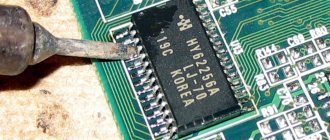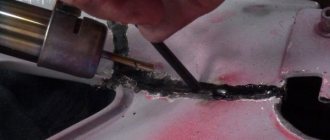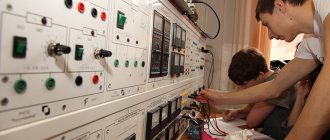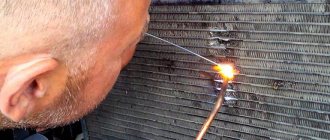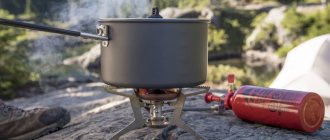Plastic welding is an effective way to lay polypropylene pipes and repair plastic products. A uniform seam is obtained by heating and melting. Special devices are designed for this. Anyone can learn to work with them. When choosing a technology, the advantages and disadvantages of each method are taken into account.
Welding plastic is the most economical technological method.
General information about welding thermoplastics
Connecting plastic parts by heating is a technology that has long been used in industrial settings and home workshops. The use of hot methods is only possible when working with materials belonging to the group of thermoplastics. This is the name for types of polymers that fully retain their characteristics after heating, melting and cooling. This is their difference from thermosets, which are destroyed by heating and final processing.
At high temperatures, such materials burn, while thermoplastics melt.
Solution 1: Gluing
This repair method is quite simple. It will require a special glue, we use dichloroethane, it is the most affordable and glues ABS plastic perfectly. You will also need a brush, preferably a synthetic one. It is convenient because after the first use, the glued hardened hairs can be trimmed, and the rest of them can be heated, the hairs will fluff up, and the brush will still serve you.
So, take a brush, moisten it in dichloroethane, apply it to the parts or parts to be glued - first on one, then on the other. It is better to put the composition in two layers, since the first, preliminary one, will begin to actively corrode the plastic... We apply the parts to each other, press and wait. Dichloroethane takes quite a long time to dry, up to six hours. With patience, we get the whole part!
Types of plastic with weldability characteristics
The joining method is chosen in accordance with the type of polymer and its characteristics.
They are distinguished by high weldability:
- Polyethylene. Products made from such plastic are joined by melting the edges, which are then combined under pressure to prevent deformation.
- Polypropylene. The material is used in the production of pipes, which are connected using a 1500 W electric soldering iron. By increasing the temperature at the junction, the 2 elements are tightly fastened. The properties of the material help to obtain a seam that does not allow moisture to pass through.
- Polyvinyl chloride (PVC). Plastic does not deform when heated. The welded joint is strong and uniform.
Polypropylene is a synthetic thermoplastic non-polar polymer.
The following polymers have medium or low weldability:
- Polystyrene. The polymer is used in the manufacture of dishes, toys, and household items. Parts made from this polymer have rather poor weldability and require careful preparation.
- Polyvinyl chloride. It is not recommended to use hot methods when comparing elements from such a polymer. This is explained by the possibility of edge deformation, which impairs the quality of the seam. Cold methods are more effective.
We recommend reading: How to solder polypropylene pipes
Hot welding methods and necessary equipment
The following tools are used to connect plastic elements by heating:
- manual units that produce a stream of hot air;
- extruders;
- devices for joining sheet polymers;
- automatic welding units.
A plastic welding hairdryer can be used to join any thermoplastics.
To choose the right thermoplastic welding tool, you need to study the operating principles, advantages and disadvantages of each device.
Handheld hair dryer or gun
Together with such equipment, a consumable material is used - a rod, which is placed between the elements to be connected. After this, the seam is heated with a construction hairdryer. The device resembles a household appliance used for drying and styling hair. The temperature and power of an industrial hair dryer are higher. Thanks to this, the edges of the elements being welded are melted, forming a homogeneous mass. As it hardens, it holds the parts together.
The temperature of the air stream is adjusted automatically or manually. The kit includes attachments that help connect plastic elements end-to-end or overlapping. The nozzle configuration is selected depending on the type of plastic, the thickness of the parts, and the experience of the welder.
Household hair dryers are used to perform routine operations. Industrial options are designed for laying polymer pipelines.
Extruder
The device is similar to a gun, at the end of which there is a nozzle for fixing a filler rod or tube.
An extruder is a machine for continuous processing of polymer raw materials.
The operating principle is based on:
- heating the consumable to a semi-liquid consistency;
- removing mass to the junction of parts;
- solidification of the melt followed by the formation of a seam.
Using an extruder, you can weld elements of any thickness in one pass. The performance of the device is higher than that of a hair dryer. The main disadvantage is the inability to weld products made from different types of plastic. This is due to the difference in melting temperatures. Before starting work, the edges of the parts are cleaned of traces of dirt and grease that can impair the quality of the seam.
We recommend reading: Heating temperature of polypropylene when soldering pipes
contact welding
The equipment produces short-term heat pulses applied in combination with pressure. The devices are used at production sites where welded polymer sheets are produced.
Extruder Application
An extruder is a device for supplying filler material to the welding area. Its use greatly simplifies the welding process.
A manual plastic extruder looks like a gun combined with a heat gun. An filler rod is continuously fed through it, surrounded by a stream of hot air.
Extruders are divided into 2 types - non-contact and contact. In the first case, the nozzle is not immersed in the weld, and the pressure is provided by the pressure roller.
In the second case, the nozzle of the apparatus passes directly inside the weld, and this applies the necessary pressure. The extrusion method of welding plastic is the simplest, fastest and most reliable among all types of manual welding; it is second only to automatic and semi-automatic methods.
Gas welding
This option refers to thermal methods of joining plastic products.
How to choose gas for hot welding
Oxygen or argon is often used as a heat source. However, the most economical gas is considered to be air, which does not have a negative effect on plastic.
Oxygen, hydrogen or argon are used as welding gases.
Ultrasound method
The universal method of heat welding involves local heating of the joint to a temperature close to the melting parameter. The dosed thermal effect does not contribute to overheating and deformation of the material, which is sometimes observed when using other methods. The equipment operates with a frequency of 17-45 kHz.
Electrical vibrations turn into mechanical vibrations, which are transmitted to the material being processed.
High frequency welding
The economical method is used in many industries. Welding is carried out using 2 metal electrodes, between which a current with a frequency of 30-75 MHz circulates. A high-frequency electric field heats the edges of the parts to the required temperature. After matching, the edges are cooled naturally. The method is suitable for connecting elements with a thickness of 0.5-2 mm. In this case, 2 welding methods are used: overlap or butt.
High-frequency welding is a pressure welding method in which the edges of parts are heated by current.
Friction method
Strong friction contributes to the release of thermal energy, which partially melts the edges of the parts. Compression under high pressure leads to the formation of a uniform, strong seam. The main advantage of the friction method is high productivity. The disadvantage is that it can only be used for welding hard types of thermoplastics.
Using a laser
Due to its high cost, this technology is rarely used in domestic settings.
In industry, the laser method is used for:
- assembling cars on automated lines;
- production of electronic devices, which requires careful handling of small plastic parts;
- manufacturing of medical instruments and devices where it is necessary to create sterile conditions;
- packaging of meat and dairy products.
The laser method helps to weld structures of complex configurations. Other methods in this case are ineffective.
Surface dissolution
A simple technology is based on chemical melting of the edges followed by fixation under pressure. Heat can be used to speed up operation. The main disadvantage is the toxicity of the substances used in the work. The method is not recommended for use at home.
We recommend reading: Which soldering iron is the best for PPR pipes?
Selection of welding rods
These elements play the role of electrodes. They are used for soldering sheet plastic, pipes, and polyethylene objects. The size of the rods varies, as does their shape. The diameter of round bars is 3-7 mm. Rods with a square cross-section are large in size.
Plastic welding rods can be made from a wide variety of materials.
To connect polymer products, 2 types of consumables are used:
- Polyethylene rods. They have a fairly low melting point. Used for welding products made of the appropriate material using a hair dryer.
- Polypropylene rods. The elements do not deform and do not lose their working properties during long-term storage. The products are used in the assembly and repair of structures made of sheet polypropylene. Electrodes made of this material are used in conjunction with extruders that melt them to a liquid state.
Simple soldering of wires
The first example is soldering wires.
What you need
To strip the insulation from the wires you will need a stripper.
It can be used to quickly remove insulation. Side cutters, wire cutters, a knife, teeth or a soldering iron will not be able to cope with this task as easily.
Liquid rosin, or FKET, is suitable for soldering wires.
Liquid rosin best coats the wire veins. It is cheap, practical and convenient.
Which sting is better to choose
Wires require a lot of solder. A mini wave is more practical for soldering any wires than a regular cone or flat tip.
Step by step process
We remove the insulation with a stripper and twist the wires.
We apply flux to the wires to be soldered, and take the solder onto the tip. The temperature of the tip is no more than 300 °C.
With several movements back and forth we tin the twisted wires. If the solder has formed into lumps, then add it and wait for the soldering area to cool down so as not to damage the brush. Add more flux and run the soldering iron over the soldering area again. There should not be much or little solder.
It's best to tin both wires before soldering them together, but you won't be able to twist them together securely. Therefore, it is easier to immediately twist and then solder them.
Headphone repair
The main problem when repairing headphones is the resistant insulation of the wires.
Features of wire tinning
To tin such wires, you need to carefully walk over the soldering area using solder and rosin.
For soldering you will need a massive tip, a large drop of solder and liquid rosin. Flux is applied in the same way, but soldering is a little different. Now the main task is to burn the insulation. This can be done with a large drop of solder. Using longitudinal movements back and forth, apply solder to the soldering area. Insulation burns slowly. There is no need to raise the temperature above 300 °C or use acid. If we can’t tin, then we try again, but instead of rosin we use LTI-120. This flux will help tin the wires no worse than soldering acid.
Which method is better for home use?
The following technologies are most often used in everyday life:
- Welding with a soldering iron. The tool has a low price, which allows it to be used even for the simplest operations. A soldering iron is used to weld pipes, containers, and car bumpers. The tool melts the surfaces at the joint, which are then matched and fixed. This method can be used to connect pipes of different diameters.
- Gas welding. At home, use a hairdryer or burner. The heated gas melts the plastic, which helps form a uniform seam. An inexpensive welding tool helps you join plastic parts of different shapes and sizes. It is used in the repair of thin-walled polymer products. The process is carried out with or without the use of filler material. Plastic rods or strips are used as consumables.
- Extruder connection. The gun is equipped with a heating element that melts the consumable material. The equipment is also equipped with a regulator that helps change the exposure temperature. Heat losses are minimal, which explains the high efficiency of the equipment.
What's the result?
Plastic is a universal material that is often used in everyday life. And although many people believe that it is better to throw away cracked plastic than to repair it, I disagree with this.
It all depends on what exactly is broken. If a small part has fallen off and will not be touched later, it is easier to glue it back on. If the damage is large (for example, a bucket, container, part of a motorcycle or car), it is better to solder it. In general, any soldering consists of three steps: melt the plastic, connect the parts and allow to cool. If necessary, use an additional plastic rod or reinforce with mesh.
Question
Write in the comments if you have ever had to repair plastic at home? What was used in the repair, how did it behave in the future?

